Soy milk
.jpg) | |||||||
| Alternative names | Soya milk | ||||||
|---|---|---|---|---|---|---|---|
| Place of origin | China | ||||||
| Invented | c. 1365[1] | ||||||
| 33 kcal (138 kJ) | |||||||
| |||||||
|
| |||||||
| Soy milk | |||||||||||||||
| Chinese name | |||||||||||||||
|---|---|---|---|---|---|---|---|---|---|---|---|---|---|---|---|
| Traditional Chinese | 豆漿 | ||||||||||||||
| Simplified Chinese | 豆浆 | ||||||||||||||
| Literal meaning | "bean purée" | ||||||||||||||
| |||||||||||||||
| Japanese name | |||||||||||||||
| Kanji | 豆乳 | ||||||||||||||
| |||||||||||||||
Soy milk is a plant based drink produced by soaking dried soybeans and grinding them in water.
A traditional staple of East Asian cuisine, soy milk is a stable emulsion of oil, water and protein. Soy milk can be produced at home using a soy milk machine.
History
Soymilk (doujiang) originated in China, probably during the early Han dynasty (202 BCE to 9 CE), after the rotary millstone was introduced and became widely used to grind wheat.[2]:51–52 According to legend, Liu An developed soy milk for his old, ill mother; no historical evidence supports the legend.[3] It did not become widely used in China until the 1800s, when it was discovered that extended heating made it taste better and easier to digest.[2]:52
Soymilk was introduced to the US market by Vitasoy in 1979; the first domestic manufacturer of soymilk was Sunrich Food Group, which introduced its products in 1985.[4]
Name variations
There is a certain amount of confusion prevalent when it comes to beverages named soy beverage, soy drink or soy milk respectively. This is caused by several factors:
- The agricultural traditions or laws in many countries require that only milks sourced from certain lactating animals are legally allowed to be named milk when sold commercially, often only cow's milk is allowed to be named milk on the packaging, and any other milks must state the name of the respective animal (goat milk, sheep milk etc.). This leads the manufacturers of plant milks to name their products beverage or drink instead, invent fantasy based names, or omit the name entirely in favor of descriptive packaging.
- In some countries soy milk has been named soy bean beverage or soy drink for centuries, and the native population may not respond well to Western influence over the naming of their own traditional heritage foods. Therefore, a preference or competition of soy drinks versus soy milks may exist.
- In countries where traditional soy based beverages have existed for a long time, and are named beverage or drink, and yet also new, often more expensive and seemingly higher quality, and therefore sought after, types of foreign soy beverages named milk are imported, the manufacturers of the suddenly less popular drinks may claim that their products would be the only ones with certain nutritional or dietetic benefits, to increase their marketability (lower in fat, higher in nutrients etc.).[5] However both types are just the same milky type soy bean based beverages, only produced, filtered and packaged in slightly different ways (as all of them have a milky look and taste, and are made almost entirely of soy beans and water), so each type can have the same benefits or disadvantages. It depends on the preferences of the customer to choose the favorite type, after comparing the pricing, reading the nutritional information on the packaging, and tasting of samples, as any type of well made soy beverage, soy drink or soy milk can be very healthy, nutritious and delicious.
- Due to worldwide market globalization different types of soy beverages, soy drinks and soy milks may be available to consumers in a country, without enough background information being available at the same time, or lower educational levels of the population leading to misunderstandings, which can contribute to confusion, and different urban legends or popular word of mouth tales replacing the actual facts and information.
Nutrition
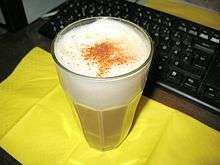
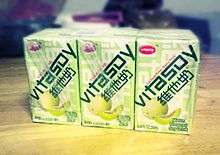
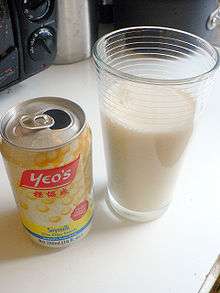
| Nutritional content of cows', soy and almond milk | |||
|---|---|---|---|
| Cows' milk (whole, vitamin D added)[6] | Soy milk (unsweetened; calcium, vitamins A and D added)[7] | Almond milk (unsweetened)[8] | |
| Calories (cup, 243 g) | 149 | 80 | 40 |
| Protein (g) | 7.69 | 6.95 | 1 |
| Fat (g) | 7.93 | 3.91 | 2.5 |
| Saturated fat (g) | 4.55 | 0.5 | 0 |
| Carbohydrate (g) | 11.71 | 4.23 | 2 |
| Fibre (g) | 0 | 1.2 | 1 |
| Sugars (g) | 12.32 | 1 | 0 |
| Calcium (mg) | 276 | 301 | n/a |
| Potassium (mg) | 322 | 292 | 170 |
| Sodium (mg) | 105 | 90 | 180 |
| Vitamin B12 (µg) | 1.10 | 2.70 | n/a |
| Vitamin A (IU) | 395 | 503 | n/a |
| Vitamin D (IU) | 124 | 119 | n/a |
| Cholesterol (mg) | 24 | 0 | 0 |
In a 100 ml (gram, g) serving, one commercial, nutrient-fortified brand of soy milk provides 80 calories from 4 g of carbohydrates, including 1 g of sugar, 4 g of fat and 7 g of protein.[7] This processed soy milk contains appreciable levels of vitamin A, B vitamins and vitamin D in a range of 10 to 45% of the Daily Value, with calcium and magnesium also in significant content.[7]
Taste
Soy milk flavor quality differs according to the cultivar of soy bean.[9] Soy milk aroma, smoothness and thickness in the mouth, color and creamy appearance are considered desirable qualities, with favored sensory attributes associating with protein content, soluble solids, and oil content.[10]
In a study of taste attributes, soy milk flavored with vanilla or sweet aromatic flavors and higher viscosity was preferred by most subjects, while dislike factors were bean or broth flavors.[11] In another study, 54% of participants preferred the taste of cow's milk, while 27% preferred soy milk, with sweetness and cream qualities identified as important flavor preferences.[12]
Preparation
Soy milk can be made from whole soybeans or full-fat soy flour. The dry beans are soaked in water overnight or for a minimum of 3 hours or more depending on the temperature of the water. The rehydrated beans then undergo wet grinding with enough added water to give the desired solids content to the final product. The ratio of water to beans on a weight basis should be about 10:1. The resulting slurry or purée is brought to a boil in order to improve its nutritional value by heat inactivating soybean trypsin inhibitor, improve its flavor and to sterilize the product. Heating at or near the boiling point is continued for a period of time, 15–20 minutes, followed by the removal of an insoluble residue (soy pulp fiber or okara) by filtration.
There is a simple yet important difference between traditional Chinese and Japanese soy milk processing: the Chinese method boils the filtrate (soy milk) after a cold filtration, while the Japanese method boils the slurry first, followed by hot filtration of the slurry. The latter method results in a higher yield of soy milk but requires the use of an anti-foaming agent or natural defoamer during the boiling step. Bringing filtered soy milk to a boil avoids the problem of foaming. It is generally opaque, white or off-white in color, and approximately the same consistency as cow's milk.
It is necessary to heat all soybean protein products to destroy the activity of the protease inhibitors naturally present in the raw soybean.
When soybeans absorb water, the endogenous enzyme, Lipoxygenase (LOX), EC 1.13.11.12 linoleate:oxidoreductase, catalyzes a reaction between polyunsaturated fatty acids and oxygen {hydroperoxidation}. LOX initiates the formation of free radicals, which can then attack other cell components. Soybean seeds are the richest known sources of LOXs, which are thought to be a defensive mechanism by the soybean against fungal invasion.
In 1967 experiments at Cornell University and the New York State Agricultural Experiment Station at Geneva, New York led to the discovery that paint-like, off-flavors of traditional soy milk can be prevented by rapid hydration and grinding of dehulled beans at temperatures above 80 °C. The quick moist heat treatment inactivates the LOX enzyme before it can have a significant undesirable effect on flavor. All modern soy milks are heat treated in this manner to destroy LOX.
In 1969 Mattick and Hand at Cornell University discovered that most of the so-called beany flavor in soybeans was not inherent in the beans themselves, but was produced by the enzyme lipoxygenase when the split beans came in contact with water.[13] Lipoxygenase could be inactivated and most of the beany flavor removed by either dropping unsoaked soybeans directly into boiling water, or by removing any cracked or split beans prior to soaking, then carefully dropping the soaked beans into boiling water.
Normal mature soybeans contain three LOX isozymes (SBL-1, SBL-2, and SBL-3) associated with undesirable flavor development. By 1998, one or more of these isozymes had been removed genetically from soybeans, yielding soy milk with less cooked beany aroma and flavor and less astringency.
Cooking
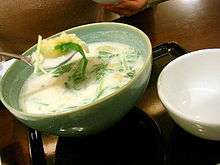
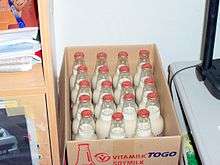
Soy milk is found in many vegan and vegetarian food products and can be used as a replacement for cow's milk in many recipes.
"Sweet" and "salty" soy milk are both traditional Chinese breakfast foods, served either hot or cold, usually accompanied by breads like mantou (steamed rolls), youtiao (deep-fried dough), and shaobing (sesame flatbread). The soy beverage is typically sweetened by adding cane sugar or, sometimes, simple syrup. "Salty" soy milk is made with a combination of chopped pickled mustard greens, dried shrimp and, for curdling, vinegar, garnished with youtiao croutons, chopped scallion (spring onions), cilantro (coriander), meat floss (肉鬆; ròusōng), or shallot as well as sesame oil, soy sauce, chili oil or salt to taste.
Soy milk is used in many kinds of Japanese cuisine, such as in making yuba as well as sometimes a base soup for nabemono.
In Korean cuisine, soy milk is used as a soup for making kongguksu, cold noodle soup eaten mostly in summer.
Tofu is produced from soy milk by further steps of curdling and then draining.
Soy milk is also used in making soy yogurt, soy cream, soy kefir and soy based cheese analogues.
Ecological impact
Using soybeans to make milk instead of raising cows may be ecologically advantageous, because the amount of soy that could be grown using the same amount of land would feed more people than if used to raise cows.[14] Cows require much more energy in order to produce milk, since the farmer must feed the animal, which can consume up to 24 kilograms (53 lb) of food in dry matter (DM) basis and 90 to 180 litres (24 to 48 US gal) of water a day, producing an average of 40 kilograms (88 lb) of milk a day. Legumes, including the soybean plant, also replenish the nitrogen content of the soil in which they are grown.
The cultivation of soybeans in South America has been cited as a cause of deforestation[15] and a range of other large-scale environmental harm.[16] The majority of soybean cultivation worldwide, especially in South America where cattle farming is widespread, is intended for livestock fodder, rather than soy milk production.[15]
See also
- List of soy-based foods
- Milk substitute
- Plant milk
- Soy milk maker
- Soy yogurt
- Tofu (soy milk curd)
- Tofu skin
References
- ↑ "History of Soymilk and Other Non-Dairy Milks (1226-2013)". Soyinfo Center, Lafayette, CA. 2016. Retrieved 15 October 2016.
Yiya Yiyi [Remnant Notions from I Ya], 1365, by Han Yi is the earliest document seen that mentions soymilk, which it calls doufujiang
- 1 2 H.T. Huang, "Early Uses of Soybean in Chinese History. Chapter 2 in The World of Soy, eds Christine M. Du Bois, Chee-Beng Tan, and Sidney Mintz. University of Illinois Press (August 4, 2008) ISBN 978-0252033414
- ↑ http://kaleidoscope.cultural-china.com/en/8Kaleidoscope12274.html
- ↑ Soyfoods Association of North America History of Soy Products
- ↑ Khoreen New for Palsgaard Asia-Pacific. Making Soy Convenient
- ↑ "Milk, whole, 3.25% milkfat, with added vitamin D", United States Department of Agriculture, Agricultural Research Service.
- 1 2 3 "Soymilk (all flavors), unsweetened, with added calcium, vitamins A and D, per 100 ml (g)". Nutritiondata.com. Conde Nast from the USDA National Nutrient Database, version SR-21. 2014. Retrieved 19 May 2016.
- ↑ "Almond Breeze Original Unsweetened", almondbreeze.com.
- ↑ Shi, X; Li, J; Wang, S; Zhang, L; Qiu, L; Han, T; Wang, Q; Chang, S. K.; Guo, S (2015). "Flavor characteristic analysis of soymilk prepared by different soybean cultivars and establishment of evaluation method of soybean cultivars suitable for soymilk processing". Food Chemistry. 185: 422–9. doi:10.1016/j.foodchem.2015.04.011. PMID 25952888.
- ↑ Ma, L; Li, B; Han, F; Yan, S; Wang, L; Sun, J (2015). "Evaluation of the chemical quality traits of soybean seeds, as related to sensory attributes of soymilk". Food Chemistry. 173: 694–701. doi:10.1016/j.foodchem.2014.10.096. PMID 25466078.
- ↑ Lawrence, S. E.; Lopetcharat, K; Drake, M. A. (2016). "Preference Mapping of Soymilk with Different U.S. Consumers". Journal of Food Science. 81 (2): S463–76. doi:10.1111/1750-3841.13182. PMID 26677062.
- ↑ Palacios, O.M.; Badran, J.; Drake, M. Anne; Reisner, M.; Moskowitz, H.R. (2009). "Consumer acceptance of cow's milk versus soy beverages: Impact of ethnicity, lactose tolerance and sensory preference segmentation". Journal of Sensory Studies. 24 (5): 731–748. doi:10.1111/j.1745-459X.2009.00236.x. ISSN 0887-8250.
- ↑ Shurtleff W, Aoyagi A (2004). "History of Whole Dry Soybeans". Soyfoods Center.
- ↑ "Livestock's long shadow - Environmental issues and options; Chapter 2, Livestock in geographic transition" (PDF). United Nations, Food and Agriculture Organization, Rome. 2006.
- 1 2 "Soy is Everywhere". World Wildlife Fund. Retrieved 14 August 2015.
- ↑ "Environmental & social impacts of soy". World Wildlife Fund. Retrieved 14 August 2015.
External links
| Wikimedia Commons has media related to Soy milk. |
| Wikibooks Cookbook has a recipe/module on |
